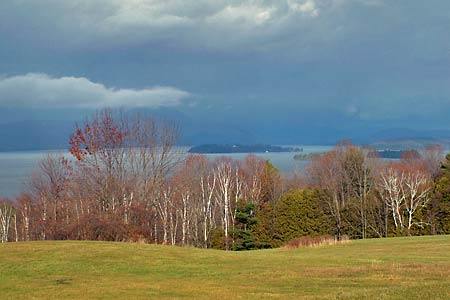LOG CABIN CHRONICLES
Toxic lake algae blooming again on Quebec-Vermont border
 © 2007 Gordon Alexander Gilles Bouchard, MD
GORDON ALEXANDER
STANSTEAD, QC | Toxic blue-green algae is again blooming in the Canadian end of Lake Memphremagog and Quebec health officials have warned two lakeshore towns not to drink and cook with the water.
The question on their Vermont neighbors' minds: Is it moving south across the border.
Some 1000 residents from the Owl's head section of Potton and St. Benoit du Lac will have to find other sources of water for cooking and drinking for a second year in a row because of the algae.
Now, lakeshore residents in four other Quebec towns have been added to the algae alert list.
And, there is now a stringent use ban around nearby Lake Massawippi that links the towns of Ayer's Cliff and North Hatley.
Harbor Master Steve Edgerley of Newport, Vermont, has been regularly taking water samples from mid-lake and shoreline locations.
People on both sides of the 30-mile-long lake, a heavily used recreation region, are getting very worried about possible negative impact on the vital tourist business.
"It is worrisome that at the beginning of the summer blue-green algae, also known as cyanobacteria, are showing up in most of our Lake waters," Gisele Lacasse Benoit, president of Memphremagog Conservation Inc.
"The lake is still open to swimmers, and the algae are not present in high enough concentrations to affect bathing or washing in the two municipalities that issued the advisory, but if the algae spreads, it could seriously affect tourism dollars in the area."
Memphremagog Conservation Inc. is a non-profit environmental organization that advocates for the protection of the lake.
Benoit says a committee needs to be set up to study sources contributing to the presence of blue-green algae in Lake Memphremagog.
"There are 4000 boats on the lake and two garbage sites not too far away that might explain why officials are finding cyanobacteria in the water."
One Canadian business -- the Monastery at St. Benoit du Lac Abbey - is already feeling the effect on its bottom line.
The famous St. Benoit cheese will now have to be made with water transported from an artificial reservoir. At the end of the summer, the monks will install a filtration system and change the entire system of pipes to ensure that cyanobacteria doesn't cause any problems in the future, an abbey spokesman says.
Last month, the Province of Quebec unveiled a $12-million plan to fight the bacteria, but Benoit says this strategy doesn't target the problem head on: "There needs to be legislation to limit the amount of phosphorus from fertilizers and pesticides in the vicinity of the province's waterways, and soil erosion needs to be curbed."
Last week, the municipalities of Ogden, Canton de Stanstead, Austin and Magog were put on alert Wednesday when health officials warned residents of riverside properties who collect their water directly from the lake. not to drink or cook with their water.
Residents of those municipalities who obtain water from a well or an aqueduct would not be affected.
The Quebec Ministry of Health has issued cyanobacteria warnings for some thirty-one lakes and rivers this year, underlining a widespread problem with the province's once pristine resources.
In 2006, The Vermont Department of Health advised Newport residents to be aware of a thick blue-green algae bloom spotted in the south end of Lake Memphremagog. It has since dissipated, but remains a on-going concern.
"The algae was thick around the waterfront walkway, city dock, and boat access in Newport," reported Bill Bress, state toxicologist for the Vermont Department of Health on the Department's website
"We want people to be careful and avoid the algae, particularly if you see it around a swimming area at Prouty Beach."
A Vermont Department of Health finding shows that skin exposure to some kinds of toxic algae can result in irritation or allergic reactions, and drinking algae that is producing toxins can result in nausea, vomiting, and diarrhea.
"If animals ingest the toxin, they can be quickly paralyzed and die. While blue-green algae toxins have been detected at many locations in Lake Champlain, the highest concentrations of toxins are usually found in blooms and shoreline scum," Bress wrote. "No human cases of illness related to blue-green algae have been documented."
Quebec officials have warned people in the area not to touch, let alone drink, the water from Lake Massawippi because of its toxicity.
The blanket ban, which goes beyond a boil-water advisory, is unprecedented in the area, said Dr. Reno Proulx, a consulting physician with the public health agency in the Eastern Townships. That's because the cyanobacteria does not respond to regular prophylactic measures.
Phosphates and nitrates that end up in lakes and rivers from household cleaning products, lawn care products, and fertilizers are believed to be largely to blame for the proliferation of cyanobacteria.
To report a blue-green algae bloom call 1-800-439-8550.
Copyright © 2007 Gordon Alexander/Log Cabin Chronicles/03.07 |